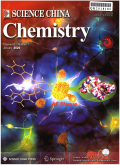- 钛学术文献服务平台 \
- 学术期刊 \
- 基础科学期刊 \
- 自然科学总论期刊 \
- 中国科学:化学(英文版)期刊 \
Small-molecule based thermally activated delayed fluorescence materials with dual-emission characteristics
Small-molecule based thermally activated delayed fluorescence materials with dual-emission characteristics
基本信息来源于合作网站,原文需代理用户跳转至来源网站获取
摘要:
Organic thermally activated delayed fluorescence (TADF) emitters have attracted increasing concerns,owing to their atypical photophysical features that can pave the way to the innovative engineering applications.As cutting-edge type of luminescent molecules,however,most of them only exert a single-wavelength emission from the lowest excited state,according to Kasha's rule.To develop their potential applications in multicolor luminescence and multi-functional luminescent probes for biological imaging,researchers have begun to turn their attention to design organic TADF molecules with dual-emission characteristics,by employing an additional fluorescence,phosphorescence,or TADF signal within a single-component system.We herein summarized the design principles as well as the luminescence mechanism of organic donor-acceptor TADF compounds with dual-emission characteristics,the superiority of which can cover unique material applications in modern luminescencerelated fields.

推荐文章
The influence of urbanization on karst rivers based on nutrient concentration and nitrate dual isoto
Urbanization
Urban river
Nitrate isotopes
Southwestern China
Chengguan River
Adsorption characteristics of copper ion on nanoporous silica
Nanoporous silica
Copper ion
Adsorption
Shadow–highlight feature matching automatic small crater recognition using high-resolution digital o
Moon
Crater recognition
Image processing
Space exploration
The occurrences and geochemical characteristics of thorium in iron ore in the Bayan Obo deposit, Nor
Thorium
Occurrence state
Distribution law
Geochemical characteristics
Iron ore
Bayan Obo deposit
内容分析
关键词云
关键词热度
相关文献总数
(/次)
(/年)
文献信息
| 篇名 | Small-molecule based thermally activated delayed fluorescence materials with dual-emission characteristics | ||
| 来源期刊 | 中国科学:化学(英文版) | 学科 | |
| 关键词 | |||
| 年,卷(期) | 2021,(4) | 所属期刊栏目 | REVIEWS |
| 研究方向 | 页码范围 | 534-546 | |
| 页数 | 13页 | 分类号 | |
| 字数 | 语种 | 英文 | |
| DOI | |||
五维指标
引文网络
引文网络
二级参考文献 (0)
共引文献 (0)
参考文献 (2)
节点文献
引证文献 (0)
同被引文献 (0)
二级引证文献 (0)
2012(1)
- 参考文献(1)
- 二级参考文献(0)
2016(1)
- 参考文献(1)
- 二级参考文献(0)
2021(0)
- 参考文献(0)
- 二级参考文献(0)
- 引证文献(0)
- 二级引证文献(0)
引文网络交叉学科
相关学者/机构
期刊影响力
中国科学:化学(英文版)
主办单位:
中国科学院
出版周期:
月刊
ISSN:
1674-7291
CN:
11-5839/O6
开本:
16开
出版地:
北京东黄城根北街16号
邮发代号:
创刊时间:
1950
语种:
eng
出版文献量(篇)
4060
总下载数(次)
0
总被引数(次)
11421
期刊文献
相关文献
推荐文献
- 期刊分类
- 期刊(年)
- 期刊(期)
- 期刊推荐
力学
化学
地球物理学
地质学
基础科学综合
大学学报
天文学
天文学、地球科学
数学
气象学
海洋学
物理学
生物学
生物科学
自然地理学和测绘学
自然科学总论
自然科学理论与方法
资源科学
非线性科学与系统科学
中国科学:化学(英文版)2022
中国科学:化学(英文版)2021
中国科学:化学(英文版)2020
中国科学:化学(英文版)2019
中国科学:化学(英文版)2018
中国科学:化学(英文版)2017
中国科学:化学(英文版)2016
中国科学:化学(英文版)2015
中国科学:化学(英文版)2014
中国科学:化学(英文版)2013
中国科学:化学(英文版)2012
中国科学:化学(英文版)2011
中国科学:化学(英文版)2010
中国科学:化学(英文版)2009
中国科学:化学(英文版)2008
中国科学:化学(英文版)2007
中国科学:化学(英文版)2006
中国科学:化学(英文版)2005
中国科学:化学(英文版)2004
中国科学:化学(英文版)2003
中国科学:化学(英文版)2002
中国科学:化学(英文版)2001
中国科学:化学(英文版)2000
中国科学:化学(英文版)2021年第7期
中国科学:化学(英文版)2021年第6期
中国科学:化学(英文版)2021年第5期
中国科学:化学(英文版)2021年第4期
中国科学:化学(英文版)2021年第3期
中国科学:化学(英文版)2021年第2期
中国科学:化学(英文版)2021年第12期
中国科学:化学(英文版)2021年第11期
中国科学:化学(英文版)2021年第1期

 免费查重
免费查重










